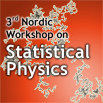Speaker
Prof.
Thomas Heimburg
(Niels Bohr Institute, Copenhagen)
Description
In the recent years, our group has explored the possibility
that electromechanical pulses (solitons) can travel along
nerve axons that share many similarities with the action
potential of nerves. The above model does not explicitly
require ion channel proteins, which are the central elements
in the textbook models for the explanation of the nervous
impulse. When a voltage is applied across the membrane, ion
channel proteins can be recognized in electrophysiological
experiments by a quantized change of current intensities in
the range of a few Pico-amperes. Thus, these currents exist
and are a proven fact. It is therefore important to address
the question of the origin of the quantized currents in the
soliton model.
Here, we show that changes in the conductance of membrane
can be the result of critical fluctuations in the lipid
membrane that leads to pore formation in the membrane. These
pores generate a current signature that is indistinguishable
from that of protein channels both in amplitude and channel
lifetime. Within a thermodynamic treatment, these phenomena
are well explainable by application of the
fluctuation-dissipation theorem. The channel lifetimes are
shown to correspond to the fluctuation timescales, and the
increased channel likelihood is explained by the large
increase of the magnitude of the fluctuations close to
transitions in the membrane, which lead to a large increase
in membrane compressibility. This phenomenon resembles that
of critical opalescence in binary mixtures of fluids.
We compare experimental traces from biological cells with
current recordings from synthetic membranes.

